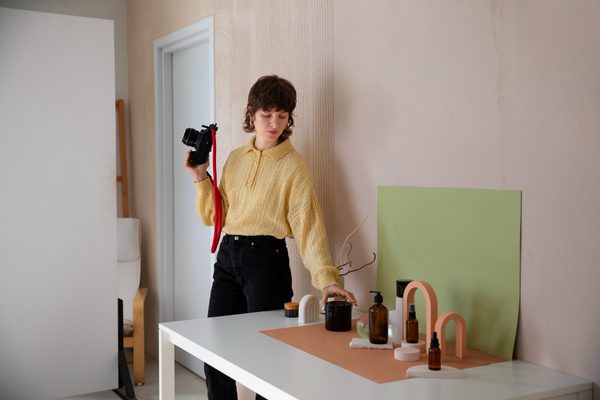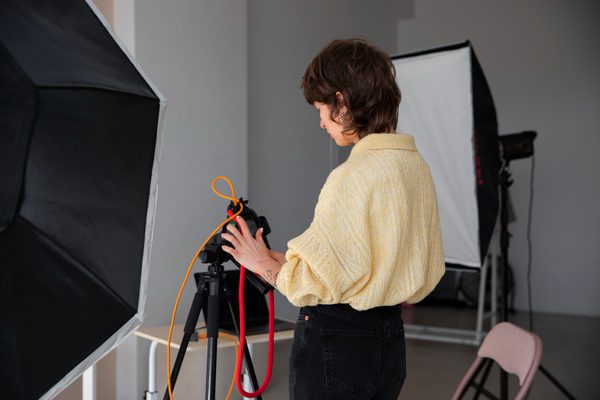Let me paint a picture for you: You’re scrolling through an online store, looking for something specific. You find the product, but the images are grainy, poorly lit, or out of focus. How do you feel? Trust me, most people wouldn’t click “Buy Now” when a product doesn’t look its best.
That’s because, in eCommerce your product photos are your first impression. We all know how important first impressions are.
The truth is simple – people shop with their eyes. When customers browse online they can’t touch, smell, or feel the product. High-quality images act as their only connection to the item.
If the product photos look good then shoppers assume the product is good too. If not, they leave, often within seconds. `
Studies show that visuals are processed 60,000 times faster than text. That’s why the quality of your photos determines whether someone stays on your site or clicks away.
I want to show you why product photography and image editing are essential for e-commerce success. These two elements can transform your store, drive sales, and build trust with your customers.
By the end of this blog, you’ll understand how important is product photography and image editing in ecommerce. Also why doing so can have a huge impact on your business.
Here’s what we’re diving into:
- The role of high-quality product photos in e-commerce.
- How important are product photography and image editing in eCommerce?
- Actionable tips to improve your product visuals.
How Important is Product Photography and Image Editing in Ecommerce
Did you know that 90% of online shoppers make buying decisions based on product photos? That’s how important is product photography and image editing in eCommerce.
When someone lands on your website, they don’t read the descriptions first. They look at the photos. Your images also need to grab their attention instantly.
Visuals act as a bridge between your product and your customer. They also create an emotional connection that no amount of text can achieve.
It can be the vibrant colors of a shirt or the sleek design of an electronic device. The right photo also helps buyers picture themselves using your product.
Building Trust Through Quality Imagery
Let me ask you this: Would you trust a product that looks poorly photographed? Probably not, right? High-quality photos make your product feel real and tangible.
This also builds trust. Customers associate clear and professional visuals with professionalism and quality.
Good visuals also reduce return rates. If your photos accurately represent your product then buyers know exactly what to expect when their order arrives.
This reduces disappointments. It can also lead to fewer complaints and more happy customers.
Examples of Brands Doing It Right
Some of the biggest e-commerce players know the value of great product photography.
Take Amazon for example. They require sellers to upload high-resolution images with plain white backgrounds.
This isn’t just for aesthetics but ensures customers focus on the product without distractions.
Similarly, fashion brands like ASOS and Zara excel in providing multiple angles, close-ups, and lifestyle shots. It also helps shoppers imagine how the product fits into their lives.
Need help with product photo editing? Contact Smart Clipping today! 🚀
The Role of Image Editing in E-commerce
From Raw Images to Perfection
Even the best photos need editing to stand out. That’s where image editing comes in.
Editing transforms raw photos into polished and professional visuals that grab attention. It also helps you fix lighting issues, adjust colors, and remove distractions.
For e-commerce, edited images ensure that your product looks its absolute best.
For example, imagine you’re selling jewelry. A raw photo might not capture the sparkle of the diamonds or the fine details of the design.
You can enhance those details and make the jewelry look irresistible with proper editing. This is why image editing for e-commerce is so important. It also ensures your products shine.

Key Image Editing Techniques for E-commerce
- Background Removal: A clean white background is a standard in e-commerce because it highlights the product and eliminates distractions. Tools like Adobe Photoshop or Canva make this process easy.
- Color Correction: Accurate colors help customers know what they’re buying. This is really important for fashion and home decor items.
- Shadows and Reflections: Adding subtle shadows or reflections gives a realistic and professional touch to your images.
Why Image Editing Impacts Conversion Rates
Here’s a fun fact: Aesthetic visuals don’t just look good but they sell better. Edited photos appeal to shoppers’ emotions and give them confidence in their purchase.
Studies also show that e-commerce stores with polished images see higher conversion rates. Customers are more likely to trust your store and complete their purchases when your photos stand out.
Related Blog Posts
15+ Best Photo Editing Tips for eCommerce
How Poor Product Photography Hurts Sales
Lost Opportunities Due to Low-Quality Photos
Let’s be real—poor product photos can drive your customers away. Think about it: When shoppers see blurry or poorly lit images, they hesitate.
Because they can’t be sure about the product’s quality, size, or color. This means they’re less likely to click “Add to Cart.”
Low-quality visuals often lead to cart abandonment too. Imagine browsing an online store and seeing unclear photos that don’t highlight key features.
You’d probably second-guess your decision, wouldn’t you? That’s exactly how customers feel when the product photos don’t answer their questions. Every unclear photo is a missed opportunity for a sale.
Negative Impact on Brand Image
Your photos are a direct reflection of your brand. Low-quality images send a message that your products might be low quality too.
It’s all about perception. Customers want to feel confident about what they’re buying. And blurry or inconsistent visuals don’t inspire trust.
For example, if one product has a bright, clear photo while another looks dark and grainy then it creates confusion.
This inconsistency also damages your brand image and makes your store look unprofessional. Building trust starts with how you present your products visually.
SEO Implications of Poor Photography
Bad product photos don’t just hurt sales. They also hurt your website’s SEO too. Low-quality images tend to have lower engagement.
This means fewer clicks, less time spent on your site, and higher bounce rates. All of this sends a negative signal to search engines.
On the other side, optimized and visually appealing product photos keep customers engaged. They stay longer, click through other pages, and are more likely to convert.
Search engines also reward these behaviors by ranking your site higher. If you’re not optimizing your product images you’re leaving potential traffic and sales on the table.
How to Start Ecommerce Photography Business : Easy Steps
How Great Photography and Editing Drive Conversions
Creating a Professional Look
Let’s talk about why great visuals matter so much. High-quality product photos also make your store look professional and trustworthy.
When customers see polished images, they assume the products and the brand are high-quality too.
A professional look also helps build a consistent brand identity. For example, using a similar style or background across all your photos makes your store look cohesive.
This visual consistency also gives your brand a polished feel, which attracts more customers and boosts conversions.
Improved User Experience
Clear and detailed product photos make shopping easier. They also help customers understand the product.
It reduces doubts and increasing confidence in their buying decisions. For example, showing multiple angles or close-ups of a product can answer common customer questions like, “How does this look from the side?” or “What’s the texture like?”
When your visuals provide all the information a buyer needs, they’re more likely to trust your store. Also, customers tend to spend more time exploring stores with great visuals.
The more time they spend, the higher the chances of them making a purchase.
Higher Engagement Across Platforms
Striking product photos don’t just work on your website but they perform well across all platforms.
On social media, visually appealing images grab attention and drive clicks. Whether it’s Instagram, Pinterest, or Facebook, good visuals help you stand out in crowded feeds.
Professional photos also improve your ad performance. Ads with clean and attractive images tend to get higher click-through rates. This means more traffic to your store and, ultimately, more sales.

Product Photography for Different E-commerce Categories
Fashion and Apparel
In the fashion industry, product photography can make or break your sales. Because customers want to see how clothing fits, how the fabric looks, and how they can style it. High-quality photos showing every detail like stitching, buttons, or texture help buyers feel more confident.
Lifestyle shots are also key for fashion. For example, showing a model wearing the outfit in a real-life setting helps customers picture themselves wearing it. These small details make a huge difference.
Jewelry and Luxury Goods
Jewelry photography is all about capturing the sparkle and elegance of your products. A raw photo might miss the shine of a diamond or the intricacy of a design.
That’s where image editing comes in. Because it enhances these details and makes the product look luxurious.
For luxury goods, every detail counts. Customers expect perfection and your photos need to be delivered.
High-quality images build the perception that your products are worth the investment.
Electronics
When it comes to electronics, functionality is key. Customers want to see the product from all angles, including close-ups of ports, buttons, and displays.
Great photography also highlights these features. This makes it easier for buyers to understand what they’re getting.
Editing also plays a big role here. Clean and distraction-free backgrounds keep the focus on the product. On the other hand, color correction ensures the photos look accurate and professional.
Home and Lifestyle
For home and lifestyle products, lifestyle photography is essential. Showing your products in a real-life setting helps customers imagine them in their own homes. For example, a cozy sofa shot in a beautifully decorated living room creates an emotional connection with the buyer.
These visuals aren’t just about aesthetics—they’re about selling a lifestyle. They show how your product can improve the customer’s life, which drives sales.
Food and Beverages
Nobody wants to buy food that doesn’t look appetizing. Bright and vibrant photos are a must in this category. Proper lighting, color correction, and editing bring out the rich textures and colors of food, making it irresistible.
If you are you’re selling a fresh salad or a decadent cake then your photos need to make people’s mouths water. Good visuals create that emotional response, which is key for driving sales in the food industry.
Need help with professional photo editing? Contact Smart Clipping today! 🚀
Actionable Tips for Better Product Photography and Image Editing
Product Photography Tips
If you’re looking to improve your product photography, here are some simple yet effective tips:
- Use natural lighting or softbox lighting for consistent, high-quality results. Natural light often works wonders for creating clear and vibrant product images.
- Invest in a good-quality camera or consider hiring a professional photographer. Even an entry-level DSLR or a high-quality smartphone can work for beginners.
- Always showcase multiple angles and close-ups of your product. Customers want to see details like textures, finishes, and overall build quality.
These steps will ensure your images highlight your product’s best features while building trust with your audience.
Image Editing Tips
Editing plays a crucial role in how your photos look online. Here’s what I suggest:
- Use tools like Adobe Photoshop, Lightroom, or free alternatives like GIMP to refine your images.
- Focus on color accuracy. The colors in your photos should closely match the real-life product.
- Add shadows and reflections strategically to make your images look professional and realistic. This small detail can make your product pop.
Well-edited photos are more likely to catch a buyer’s attention and keep them engaged longer.
Budget-Friendly Tools and Resources
If you’re just starting out, you don’t need to spend a fortune. Here are some affordable solutions:
- Use free or budget-friendly photo editing tools like Canva, Fotor, or Pixlr. They’re easy to use and offer plenty of features.
- DIY setups like a tripod and a lightbox can help you create professional-looking photos at a fraction of the cost. You can even build your own lightbox with everyday items.
Starting with budget-friendly options makes improving your visuals accessible, even for small businesses.
How to get into ecommerce photography: Expert Tips Inside
The Impact of Visuals on Marketing and SEO
Visual Content for Social Media Ads
When it comes to platforms like Instagram and Pinterest, visuals are everything. High-quality product photos can turn casual scrollers into loyal customers.
- Great visuals drive engagement. Viral campaigns often start with eye-catching photos that spark interest.
- Consistent and professional photos are more likely to be shared, increasing your reach organically.
Social media thrives on visuals, so investing in product photography and image editing is critical if you want to make an impact.
Product Photography’s Role in SEO
You might not realize it, but your product photos can help your site rank better on search engines. Here’s how:
- Optimizing images with SEO-friendly techniques, like compressing file sizes, ensures faster page load times. Faster sites rank higher on Google.
- Use ALT tags and captions for your product photos. These not only improve accessibility but also make your images more searchable.
When I think about how important product photography and image editing in eCommerce are, it’s clear that visuals directly influence both user experience and SEO.
Boosting Email Marketing Campaigns
Product visuals can also boost the performance of your email marketing efforts.
- High-quality images increase click-through rates because they grab attention right away.
- Emails with great visuals feel more professional and help build trust with potential buyers.
Whether you’re sharing a new product or running a promotion, visuals make your email campaigns far more engaging.
How much to charge for ecommerce photography: Complete Guide
Trends in Product Photography and Image Editing
AI in Image Editing
Artificial intelligence is changing the game when it comes to photo editing. Tools like Canva and Adobe’s AI-powered features can help you edit faster and more effectively.
- AI tools can remove backgrounds automatically, saving you tons of time.
- Color grading and enhancements are also becoming more automated, making advanced editing accessible to everyone.
These innovations make it easier than ever to get professional results, even if you’re a beginner.
7 Best ai photo retouching software
3D Photography and Augmented Reality (AR)
3D visuals and AR are transforming how customers shop online.
- 3D photos let customers view products from every angle, which boosts confidence in their purchase.
- Some brands now use AR to allow customers to “try before they buy.” For example, you can see how furniture looks in your home or how glasses fit on your face.
These technologies make shopping online more interactive and engaging.

Minimalist Product Photography
Minimalism is trending for a reason. Clean, distraction-free imagery helps customers focus on the product itself.
- Use plain backgrounds, natural colors, and simple props to highlight your product.
- Minimalist photos work well across all platforms, including websites, ads, and social media.
This approach makes your products the star of the show and helps you stand out in a crowded market.
Case Studies: E-commerce Brands Winning with Great Visuals
Small Business Success Stories
Great visuals can help small businesses stand out in a crowded market. For example:
- Startups on Etsy often rely on high-quality product photography to showcase their handmade items. A simple yet clear image can highlight the craftsmanship and attract buyers.
- Many Shopify store owners use visually appealing photos to tell their brand story. This not only improves their product pages but also helps build a consistent brand identity.
A good example is a small skincare brand that used professional photography to highlight textures and packaging. Their sales increased by over 40% after the update.
Big Brands Leading the Way
Big names like Amazon sellers or larger Shopify stores often take product visuals to the next level.
- Amazon product listings with sharp, detailed images tend to perform better because customers can see the product clearly.
- On platforms like Etsy, stores with great visuals consistently rank higher in search results and attract more clicks.
Take, for instance, a fitness brand on Shopify that improved its product photos by using proper lighting and minimal backgrounds. This simple change boosted customer trust and reduced return rates.
Before and After Comparisons
Nothing shows the impact of great visuals better than a before-and-after comparison.
- A plain, low-quality image can make your product look cheap.
- A professionally edited image with the right lighting, shadows, and color correction can make it look premium and desirable.
These transformations highlight how important product photography and image editing in eCommerce really are.
Conclusion
High-quality product photography and image editing aren’t optional—they’re essential. Great visuals build trust, increase sales, and improve the overall shopping experience.
If you’re ready to take your eCommerce store to the next level, it’s time to invest in better visuals. Smart Clipping can help you with professional product photography and image editing services. Whether you need background removal, color correction, or complete image retouching, we’ve got you covered.
Check out our services or reach out to learn how we can help your eCommerce business grow.
FAQs About “How Important is Product Photography and Image Editing in Ecommerce
Why is product photography so important in e-commerce?
Product photography is the first thing customers notice. A good photo builds trust and helps buyers imagine the product in their lives.
How does image editing improve online sales?
Editing improves clarity, color accuracy, and overall quality. It ensures your product looks its best and makes it stand out in a competitive market.
What tools should I use for product photo editing?
Adobe Photoshop and Lightroom are top choices for professionals. Canva and Pixlr are great for beginners or small business owners.
Can I do product photography myself?
Yes, you can. Start with good lighting, a decent camera, and a plain background. For editing, use beginner-friendly tools.
How do good images boost my e-commerce SEO?
Good images improve page load times and user engagement, which positively affects your SEO. ALT tags and descriptive file names also make your product images more discoverable on search engines.


